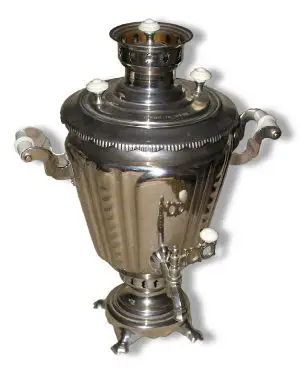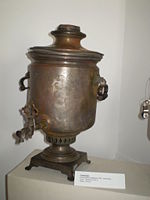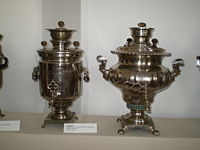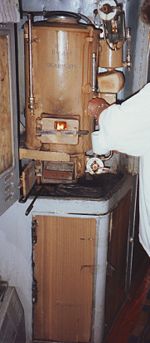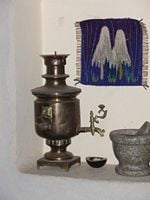Difference between revisions of "Samovar" - New World Encyclopedia
| Line 22: | Line 22: | ||
During the nineteenth century, samovars gained increasing popularity in major cities, such as [[Saint Petersburg]] and Moscow, and became inseparably bound to the Russian way of life. Classics of Russian literature, like [[Pushkin]], [[Gogol]] and [[Anton Chekhov|Chekhov]], regularly mention samovars in their works. Chekhov even coined an idiom: ''to take one's own samovar to Tula''. This phrase is still understood and occasionally used by most Russians, with a meaning similar to ''[[Selling coal to Newcastle|carry coals]] to [[Newcastle upon Tyne|Newcastle]]'' in the [[Great Britain]]. | During the nineteenth century, samovars gained increasing popularity in major cities, such as [[Saint Petersburg]] and Moscow, and became inseparably bound to the Russian way of life. Classics of Russian literature, like [[Pushkin]], [[Gogol]] and [[Anton Chekhov|Chekhov]], regularly mention samovars in their works. Chekhov even coined an idiom: ''to take one's own samovar to Tula''. This phrase is still understood and occasionally used by most Russians, with a meaning similar to ''[[Selling coal to Newcastle|carry coals]] to [[Newcastle upon Tyne|Newcastle]]'' in the [[Great Britain]]. | ||
| − | In the second half of the century, samovar manufacturing took root in Moscow, Saint Petersburg and some industrialized parts of [[Siberia]] and the [[Ural (region)|Ural]] region. However, Tula retained its leading and standard-setting role in this trade. By that time, four shapes of samovars became traditional: cylindric, barrel-like, spherical and the most beautiful of them all, | + | In the second half of the century, samovar manufacturing took root in Moscow, Saint Petersburg and some industrialized parts of [[Siberia]] and the [[Ural (region)|Ural]] region. However, Tula retained its leading and standard-setting role in this trade. By that time, four shapes of samovars became traditional: cylindric, barrel-like, spherical, and the most beautiful of them all, the ''samovar vaznoy'' resembling the ancient Greek vase called ''[[krater]].'' |
The beginning of the twentieth century was marked by various attempts at innovation. The traditional heating method was challenged by petroleum, kerosene, gas, and other means of heating. However, these models proved unpopular, due to the odor of the fuels and the dangers of inflammation and explosion. | The beginning of the twentieth century was marked by various attempts at innovation. The traditional heating method was challenged by petroleum, kerosene, gas, and other means of heating. However, these models proved unpopular, due to the odor of the fuels and the dangers of inflammation and explosion. | ||
Revision as of 21:13, 24 January 2009
A samovar (Russian: самовар, Russian pronunciation: [səmɐˈvar] literally "self-boiler") is a heated metal container traditionally used to heat and boil water in and around Russia, as well as in other Central, South-Eastern and Eastern European countries, in Iran, Kashmir and Turkey. Since the heated water is usually used for making tea, many samovars have an attachment on the tops of their lids to hold and heat a teapot filled with tea concentrate. Samovars are said to have been invented in Central Asia, though their origin is a matter of dispute. For example, some argue that it is purely a Russian invention given that the samovar appeared in Iran not later than in eighteenth century, and it bears the same Russian name "samovar."
Though traditionally heated with coal or charcoal, many newer samovars use electricity and heat water in a similar manner as an electric water boiler.
History
The samovar's precursor was сбитенник (sbitennik), an implement for heating сбитень (sbiten), a hot winter drink of honey and spice. A sbitennik looked like a metal teakettle fitted with a heater pipe and legs, similar to a samovar.
In the late eighteenth century, a Russian gunsmith, Fedor Lisitsyn, set up a small workshop south of Moscow, in the city of Tula, the heart of the Russian defense industry. Lisitsyn and his two sons were laboring in their time free from making arms and ammunition on a rather unusual device, which had been hitherto handcrafted by individual craftsmen in the Ural region solely for personal use: the charcoal-burning samovar.
Lisitsyn's workshop was the first to produce samovars industrially and had tremendous success. Shortly afterward, many competing samovar factories were starting operations nearby. By the 1830s, Tula established itself as the capital of samovar-making.
During the nineteenth century, samovars gained increasing popularity in major cities, such as Saint Petersburg and Moscow, and became inseparably bound to the Russian way of life. Classics of Russian literature, like Pushkin, Gogol and Chekhov, regularly mention samovars in their works. Chekhov even coined an idiom: to take one's own samovar to Tula. This phrase is still understood and occasionally used by most Russians, with a meaning similar to carry coals to Newcastle in the Great Britain.
In the second half of the century, samovar manufacturing took root in Moscow, Saint Petersburg and some industrialized parts of Siberia and the Ural region. However, Tula retained its leading and standard-setting role in this trade. By that time, four shapes of samovars became traditional: cylindric, barrel-like, spherical, and the most beautiful of them all, the samovar vaznoy resembling the ancient Greek vase called krater.
The beginning of the twentieth century was marked by various attempts at innovation. The traditional heating method was challenged by petroleum, kerosene, gas, and other means of heating. However, these models proved unpopular, due to the odor of the fuels and the dangers of inflammation and explosion.
Railroad companies in Russia recognized the practicality and popularity of samovars, and fitted long-distance sleeping cars with them. Luxurious cars of the Trans-Siberian railroad were first to adopt this custom. Gradually, the samovar in a railroad car was replaced by the boiler of potable water known as титан (titan) in the Soviet Union. Usually the titan is located at the end of the hallway, next to the conductor's closet, for the self-service of any passengers who may need some hot water during a long journey. Titans have all sorts of automatic controls, including temperature and water level (a notable advance over a samovar) with the counter-aesthetical beauty of the technical revolution. Samovars were retained only in luxury cars under the immediate supervision of the conductor.
During World War I and the subsequent turmoil of revolution and civil war, the design and the production technology of samovars were largely simplified and made fit for the military. Roughly welded cylindric samovars devoid of decoration are characteristic of this period.
The late 1920s and early 1930s saw Stalinist collectivization and industrialization. Small samovar-making workshops were integrated into vast factories or disbanded. Quantity took priority over quality. However, it was during this period that the largest samovar-manufacturer of the Soviet Union, the "Shtamp" ("Штамп") company, was founded, in Tula.
The 1950s and 1960s brought significant changes to the world, and brought forth the invention of the nickel-plated electric samovar.
The hitherto undisputed reign of the charcoal-burning samovar came to an end. The gentle flavor of smoke proved to be insufficient in the face of such benefits as the ease of use and convenience, reduced tea-brewing time and the ease of cleaning, let alone the longevity provided by the nickel-plating that protects brass from corrosion. Catering facilities and households embraced the new technology swiftly; only the railroads remained faithful to the smoky, charcoal-fueled, traditional samovar.
The period of Brezhnevian stagnation did not leave any marks on the samovar. In fact, only the Olympic games of 1980, during which an incredible amount of samovars were sold to visitors from abroad, affected the samovar: it gained international recognition and became a symbol of Russia.
With the 2nd dawn of capitalism in Russia in the nineties, competition returned to the samovar industry as well. Recent spin-offs of the Shtamp corporation are now competing for their share of the samovar market with newly founded businesses.
Samovars also play a prominent role in Polish history and cuisine.
In modern times, the samovar is mostly associated with Russian exotica and nostalgia, though they are also quite popular with Iranian immigrants and their descendants. Today electric samovars are available. Samovars may be purchased in Europe, and in the US they may be found in neighborhoods with heavily Slavic populations, such as New York's East Village or Coney Island in Brooklyn, or in areas with large Iranian populations like Los Angeles, California.
Description
Samovars come in different body shapes: urn- or krater-shaped, barrel, cylindric, spherical.
A typical samovar consists of a body, base and chimney, cover and steam vent, handles, faucet and key, crown and ring, chimney extension and cap, drip-bowl, and teapots.
A traditional samovar consists of a large metal container with a faucet near the bottom and a metal pipe running vertically through the middle. Samovars are typically crafted out of copper, brass, bronze, silver, gold, tin or nickel. The pipe is filled with solid fuel to heat the water in the surrounding container. A small (6 to 8 inches) smoke-stack is put on the top to ensure draft. After the fire is off a teapot could be placed on top to be kept heated with the passing hot air. The teapot is used to brew the заварка (zavarka), a strong concentrate of tea. The tea is served by diluting this concentrate with (кипяток) kipyatok (boiled water) from the main container, usually at a ratio of about 10 parts water to one part tea concentrate, although tastes vary.
Use
The samovar is particularly well-suited to tea-drinking in a communal setting over a protracted period. The Russian expression "to have a sit by samovar" means to have a leisurely talk while drinking tea from samovar. This compares with the Japanese tea ceremony, but only superficially.
In everyday use it was an economical permanent source of hot water in older times. Various slow-burning items could be used for fuel, such as charcoal or dry pinecones. When not in use, the fire in the samovar pipe was faintly smouldering. When necessary, it was quickly rekindled with the help of bellows. Although a Russian jackboot сапог (sapog) could be used for this purpose, there were bellows manufactured specifically for use on samovars.
The samovar was an important attribute of a Russian household. Sizes and designs varied, from "40-pail" ones of 400 litres (100 US gallons) to 1 litre (1 US quart) size, from cylindrical to spherical, from plain iron to polished brass to gilt.
Charcoal-burning samovars are now strictly outdoor equipment. The first thing to do with a samovar is to clean it thoroughly and fill it up with water through its open hatch. A properly-maintained samovar with a shining finish is a sign of hospitality and good manners of the host. Set the samovar on a large tray to keep the ashes which work their way through the vent from damaging the table, also to catch any dripping water.
Afterwards, fuel is added. Instead of charcoal, Russians traditionally use dry pinecones. Cones add a hint of the resin's flavor to the tea. When using charcoal it is important to use unprocessed lump charcoal. Commercial compressed charcoal can burn with such a concentrated heat that it is possible to damage the samovar, especially if the water level falls too low.
No matter what fuel is used, it must be ignited. The traditional way is to use pieces of bark from the birch tree or small dry fir tree twigs called pautina (cobweb). In the Soviet era, a popular joke had it that Pravda, the newspaper of the Communist Party, was particularly good for tinder. Paper in general should work. An alternate method is to set the charcoal burning in a fireplace or brazier and transfer the coals to the samovar with tongs.
As soon as the igniting substance and smaller pieces of the fuel catch fire, one needs to pump on the upper end of the tube, in order to help the fire burn. Finally, attach the chimney extension and wait until the water boils. If the fire is strong a gallon of water can be brought to a full boil in approximately 20 minutes. In order to abate the fire, put the cap on the tube instead of the chimney. To stimulate the heater, apply the pump.
Electric samovars can operate indoors. Their operation is much simpler, since the only thing necessary to begin heating is to plug it into the AC outlet. Whether or not the samovar has a water level switch as was previously mentioned, the heater must be fully immersed in water when turned on.
Variations
Charcoal-burning samovar
The parts of the samovar, from the bottom up, are as follows:
Nearly all samovars have a four-legged square-shaped foundation. This keeps the samovar from damaging the furniture with its heat. Above that, we find the "neck" of the samovar, or шейка, sheika in Russian. The neck thickens towards its top, where the ventilation chamber is located. This chamber has small intake holes along its perimeter in order to supply the combustion process with oxygen. The foundation and the neck are together referred to as поддон, poddon.
Above this is the actual boiler. Inside is a thick tube (in Russian труба, truba) which constitutes the combustion chamber. The bottom of this tube is separated from the ventilation chamber with bars to prevent the fuel from falling inside. This separation is called колосник, kolosnik in Russian.
Near the bottom of the boiler, a small faucet (кран, kran) protrudes from the tank. It consists of three parts: a small decoration at its stem (the репеёк, repeyok "thistle") that contributes to the rigidity of the mounting, the pipe itself, and simple valve with a handle (ветка, vetka). The valve is essentially a funnel with a hole. In the two extreme positions of the handle the valve is closed, while in the central position the water can pour through the hole. It is the weight of the valve and the handle that keeps the whole thing in place; you can simply pull it out upwards.
The hatch of the boiler has two small handles protecting one's hands from the heat. These two handles are called "cones," or шишки, shishki. There are also small steaming holes (душники, dushniki) on the hatch. Their purpose is to prevent the samovar from exploding due to pressure, and to steam the teapot at the same time.
The whole construction is topped off by a crown-like teapot socket, often decorated with some ornament. This part of the samovar is called конфорка, konforka or камфорка, kamforka.
Finally, charcoal-burning samovars come with two accessories: a cap and a chimney extension for the tube. Both need to be placed onto the open end of the heating tube, though not at the same time.
Electric samovar
Rather than enumerating all the parts of the electric samovar, it is best to highlight the differences from its predecessor.
The first—and most important—difference is the look and the purpose of the thicker part of the neck: instead of ventilation holes, one finds one large electric socket on its perimeter; in the place of the empty ventilation chamber of the charcoal-burner, the electric samovar has a packed electric compartment.
The most apparent difference, however, is arguably the lack of the characteristic tube of the charcoal samovar. The huge spiral of an electric immersion heater occupies the tube's place.
Inside the ventilation chamber, which can be accessed by unscrewing the nut at the bottom of the samovar, one will find the connections of the heating coil. The coil itself is insulated from the spiral's body (and thus the samovar itself) by a set of ceramic rings. The coil with the white insulator rings resembles the backbone of a fish, if pulled out of its heater.
The last important distinguishing feature of the electric samovar is the position of the steaming holes; The lack of the tube allows for a more convenient place right at the center of the kamforka.
Some samovars have a special floating device near the heater, which turns it off if the water in the tank does not engulf the spiral entirely. This design is less common as it creates an additional moving part which might be prone to failure. The only moving part in a samovar is often the valve of the faucet.
Samovars in Iran
In Iran, samovars have been used at least for two centuries and electrical, oil-burning or natural gas-consuming samovars are still being used everywhere. Samovar is pronounced as samāvar in Persian and it was originally imported from Russia but Iranian craftsmen used Persian art and Kurdish art to produce artful samovars. The Iranian city of Borujerd has been the main centre of making samovars and a few workshops are still producing hand-made samovars. Borujerd’s samovars are often made with German silver which is a part of its famous Varsho-Sazi art. The art samovars of Borujerd are often shown in Iranian and Western countries' museums as a part of Iranian art.
Gallery
An eighteenth-century samovar of Baroque shape, depicted on a 1989 USSR postage stamp.
ReferencesISBN links support NWE through referral fees
- Israfil, Nabi. 1990. Samovars: The Art of the Russian Metal Workers, Fil Caravan Inc. ISBN 0962913804
- Gautier, Lydia. 2006. Tea: Aromas and Flavors Around the World. San Francisco, CA: Chronicle Books. ISBN 978-0811856829
- Heiss, Mary Lou, and Robert J. Heiss. 2007. The Story of Tea: A Cultural History and Drinking Guide. Berkeley, CA: Ten Speed Press. ISBN 978-1580087452
- Pettigrew, Jane, and Bruce Richardson. 2008. The New Tea Companion. Perryville, KY: Benjamin Press. ISBN 978-0979343179
- Nagy, Dániel. 2002. The Samovar, Russian Tea HOWTO. Retrieved December 18, 2008.
- Price, Massoume. 2008. Making tea, Russian Samovars Recipes and Major Ceremonial Dishes and Items, Culture of Iran. Retrieved December 18, 2008.
| ||||
| Black tea | Blended and flavored teas | Chinese tea | Earl Grey tea | Green tea | Herbal tea | Lapsang souchong | Masala chai | Mate tea | Mint tea | Oolong tea | Turkish tea | White tea | Yellow tea | ||||
| Tea culture | Related to tea | |||
| China | India | Japan | Korea | Morocco | Russia | United Kingdom | United States | Samovar | Tea house | Teapot | Tea set | |||
Credits
New World Encyclopedia writers and editors rewrote and completed the Wikipedia article in accordance with New World Encyclopedia standards. This article abides by terms of the Creative Commons CC-by-sa 3.0 License (CC-by-sa), which may be used and disseminated with proper attribution. Credit is due under the terms of this license that can reference both the New World Encyclopedia contributors and the selfless volunteer contributors of the Wikimedia Foundation. To cite this article click here for a list of acceptable citing formats.The history of earlier contributions by wikipedians is accessible to researchers here:
The history of this article since it was imported to New World Encyclopedia:
Note: Some restrictions may apply to use of individual images which are separately licensed.
